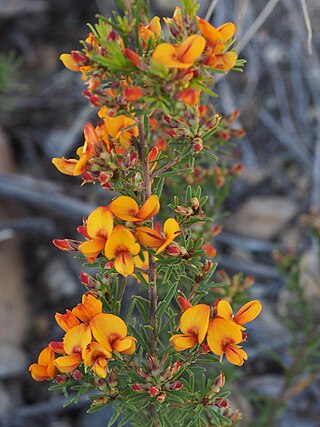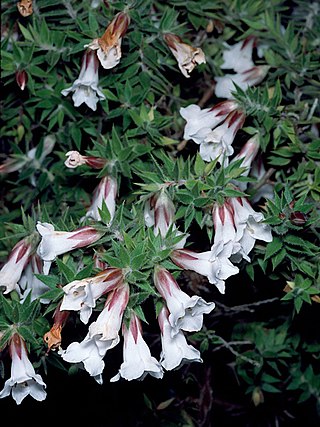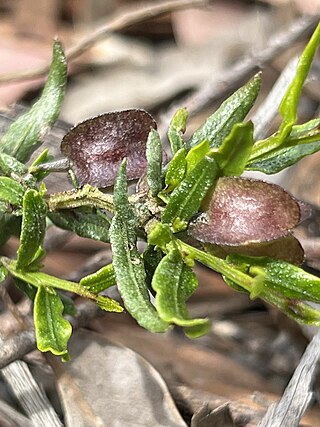
Pultenaea scabra, commonly known as rough bush-pea, is a species of flowering plant in the family Fabaceae and is endemic to south-eastern continental Australia. It is an erect or spreading shrub with hairy stems, heart-shaped leaves with the narrower end towards the base, and yellow and red, pea-like flowers.

Boronia granitica, commonly known as granite boronia, is a plant in the citrus family, Rutaceae and is endemic to a small area of eastern Australia. It is an erect shrub with many branches, compound leaves and pink, four-petalled flowers.

Boronia repanda, commonly known as the granite rose, repand boronia or border boronia, is a plant in the citrus family Rutaceae and is endemic to an area near the eastern border between New South Wales and Queensland in Australia. It is a small erect, woody shrub with many branches, thick warty, oblong leaves and pink, rarely white flowers arranged singly in leaf axils.

Pultenaea villosa, commonly known as hairy bush-pea, is a species of flowering plant in the family Fabaceae and is endemic to eastern Australia. It is a shrub with softly-hairy foliage, narrow elliptic to linear, oblong to club-shaped leaves, and yellow-orange and reddish-brown, pea-like flowers.

Prostanthera granitica, commonly known as the granite mintbush, is a species of flowering plant in the family Lamiaceae and is endemic to eastern Australia. It is a spreading shrub with egg-shaped leaves with the edges rolled under, and purple to violet flowers.

Prostanthera teretifolia, commonly known as turpentine bush, is a species of flowering plant in the family Lamiaceae and is endemic to a restricted area of New South Wales. It is an erect to spreading, aromatic shrub with more or less cylindrical leaves and bluish-purple flowers.

Hibbertia elata is a species of flowering plant in the family Dilleniaceae and is endemic to a eastern Australia. It is an open shrub with hairy stems, clustered, narrow linear to narrow lance-shaped leaves with the narrower end towards the base, and yellow flowers usually with fifteen to twenty-five stamens arranged around the three carpels.

Pultenaea foliolosa, commonly known as the small-leaf bush-pea, is a species of flowering plant in the family Fabaceae and is endemic to eastern Australia. It is an erect to low-lying shrub with elliptic to oblong leaves that are concave on the upper surface, and yellow to orange and reddish-brown flowers.

Bossiaea concolor is a species of flowering plant in the family Fabaceae and is endemic to eastern Australia. It is an erect shrub with elliptic to oblong or egg-shaped leaves with the lower end towards the base, and yellow and red flowers.

Pultenaea largiflorens, commonly known as twiggy bush-pea, is a species of flowering plant in the family Fabaceae and is endemic to south-eastern continental Australia. It is a rigid, erect shrub with narrow egg-shaped leaves with the narrower end towards the base, and bright yellow and crimson flowers.

Pultenaea linophylla, commonly known as halo bush-pea, is a species of flowering plant in the family Fabaceae and is endemic to south-eastern continental Australia. It is an erect or prostrate shrub with spreading branches, linear to elliptic or wedge-shaped leaves, and yellow to orange and red to purple flowers.

Pultenaea luehmannii, commonly known as thready bush-pea, is a species of flowering plant in the family Fabaceae and is endemic to the Grampians National Park. It is a diffuse, more or less prostrate sub-shrub with trailing branches, narrow elliptic leaves, and orange and dark brown flowers.
Pultenaea rodwayi is a species of flowering plant in the family Fabaceae and is endemic to south-eastern New South Wales. It is an erect shrub with hairy branchlets, linear leaves, and yellow to orange and red, pea-like flowers.

Pultenaea vrolandii, commonly known as cupped bush-pea, is a species of flowering plant in the family Fabaceae and is endemic to south-eastern continental Australia. It is an erect shrub with hairy, arching branchlets, elliptic to egg-shaped leaves, and yellow to orange and red to brown flowers.

Pultenaea campbellii commonly known as New England bush-pea or ragged bush-pea, is a species of flowering plant in the family Fabaceae and is endemic to New South Wales. It is an erect shrub with linear leaves and yellow-orange flowers arranged near the ends of branchlets.
Lasiopetalum longistamineum is a species of flowering plant in the family Malvaceae and is endemic to a restricted area of New South Wales. It is a spreading shrub with its branches densely covered with woolly, rust-coloured hairs and has egg-shaped leaves and woolly-hairy flowers.

Epacris hamiltonii is a species of flowering plant in the family Ericaceae and is endemic to the Blue Mountains in New South Wales. It is a slender, low-lying to ascending shrub with hairy branchlets, thin, flat, hairy egg-shaped leaves, and white, tube-shaped flowers arranged in small groups at the end of branches.

Dodonaea camfieldii is a species of plant in the family Sapindaceae and is endemic to New South Wales. It is a small plant with single or paired flowers and mostly simple leaves.

Androcalva procumbens is a species of flowering plant in the family Malvaceae and is endemic to central New South Wales. It is a prostrate shrub covered with star-shaped hairs, and with slender, trailing stems, egg-shaped to narrowly egg-shaped or lance-shaped leaves with scalloped or lobed edges, and clusters of 4 to 10 white, pink and yellow flowers.

Commersonia prostrata, commonly known as dwarf kerrawang, is a species of flowering plant in the family Malvaceae and endemic to eastern continental Australia. It is a prostrate shrub with trailing branches, egg-shaped leaves, the lower surface densely covered with star-like hairs, white, petal-like sepals, and smaller, pinkish petals.


















